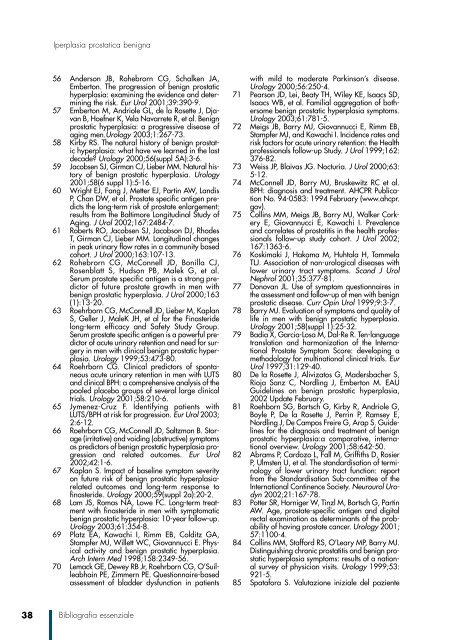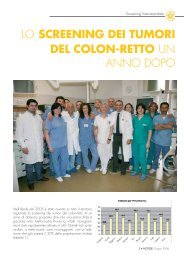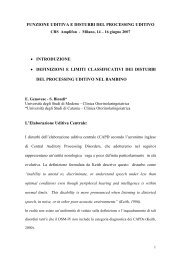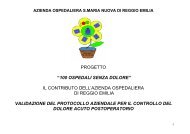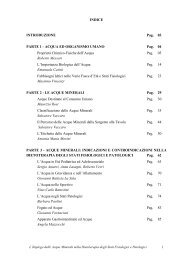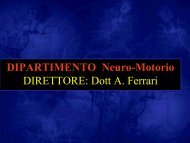versione pdf - Sistema Nazionale Linee Guida
versione pdf - Sistema Nazionale Linee Guida
versione pdf - Sistema Nazionale Linee Guida
Create successful ePaper yourself
Turn your PDF publications into a flip-book with our unique Google optimized e-Paper software.
Iperplasia prostatica benigna56 Anderson JB, Rohebrorn CG, Schalken JA,Emberton. The progression of benign prostatichyperplasia: examining the evidence and determiningthe risk. Eur Urol 2001;39:390-9.57 Emberton M, Andriole GL, de la Rosette J, DjavanB, Hoefner K, Vela Navarrete R, et al. Benignprostatic hyperplasia: a progressive disease ofaging men.Urology 2003;1:267-73.58 Kirby RS. The natural history of benign prostatichyperplasia: what have we learned in the lastdecade? Urology 2000;56(suppl 5A):3-6.59 Jacobsen SJ, Girman CJ, Lieber MM. Natural historyof benign prostatic hyperplasia. Urology2001;58(6 suppl 1):5-16.60 Wright EJ, Fang J, Metter EJ, Partin AW, LandisP, Chan DW, et al. Prostate specific antigen predictsthe long-term risk of prostate enlargement:results from the Baltimore Longitudinal Study ofAging. J Urol 2002;167:2484-7.61 Roberts RO, Jacobsen SJ, Jacobson DJ, RhodesT, Girman CJ, Lieber MM. Longitudinal changesin peak urinary flow rates in a community basedcohort. J Urol 2000;163:107-13.62 Rohebrorn CG, McConnell JD, Bonilla CJ,Rosenblatt S, Hudson PB, Malek G, et al.Serum prostate specific antigen is a strong predictorof future prostate growth in men withbenign prostatic hyperplasia. J Urol 2000;163(1):13-20.63 Roehrborn CG, McConnell JD, Lieber M, KaplanS, Geller J, MaleK JH, et al for the Finasteridelong-term efficacy and Safety Study Group.Serum prostate specific antigen is a powerful predictorof acute urinary retention and need for surgeryin men with clinical benign prostatic hyperplasia.Urology 1999;53:473-80.64 Roehrborn CG. Clinical predictors of spontaneousacute urinary retention in men with LUTSand clinical BPH: a comprehensive analysis of thepooled placebo groups of several large clinicaltrials. Urology 2001;58:210-6.65 Jymenez-Cruz F. Identifying patients withLUTS/BPH at risk for progression. Eur Urol 2003;2:6-12.66 Roehrborn CG, McConnell JD, Saltzman B. Storage(irritative) and voiding (obstructive) symptomsas predictors of benign prostatic hyperplasia progressionand related outcomes. Eur Urol2002;42:1-6.67 Kaplan S. Impact of baseline symptom severityon future risk of benign prostatic hyperplasiarelatedoutcomes and long-term response tofinasteride. Urology 2000;59(suppl 2a):20-2.68 Lam JS, Romas NA, Lowe FC. Long-term treatmentwith finasteride in men with symptomaticbenign prostatic hyperplasia: 10-year follow-up.Urology 2003;61:354-8.69 Platz EA, Kawachi I, Rimm EB, Colditz GA,Stampfer MJ, Willett WC, Giovannucci E. Physicalactivity and benign prostatic hyperplasia.Arch Intern Med 1998;158:2349-56.70 Lemack GE, Dewey RB Jr, Roehrborn CG, O’SuilleabhainPE, Zimmern PE. Questionnaire-basedassessment of bladder dysfunction in patientswith mild to moderate Parkinson’s disease.Urology 2000;56:250-4.71 Pearson JD, Lei, Beaty TH, Wiley KE, Isaacs SD,Isaacs WB, et al. Familial aggregation of bothersomebenign prostatic hyperplasia symptoms.Urology 2003;61:781-5.72 Meigs JB, Barry MJ, Giovannucci E, Rimm EB,Stampfer MJ, and Kawachi I. Incidence rates andrisk factors for acute urinary retention: the Healthprofessionals follow-up Study. J Urol 1999;162:376-82.73 Weiss JP, Blaivas JG. Nocturia. J Urol 2000;63:5-12.74 McConnell JD, Barry MJ, Bruskewitz RC et al.BPH: diagnosis and treatment. AHCPR PublicationNo. 94-0583: 1994 February (www.ahcpr.gov).75 Collins MM, Meigs JB, Barry MJ, Walker CorkeryE, Giovannucci E, Kawachi I. Prevalenceand correlates of prostatitis in the health professionalsfollow-up study cohort. J Urol 2002;167:1363-6.76 Koskimaki J, Hakama M, Huhtala H, TammelaTLJ. Association of non-urological diseases withlower urinary tract symptoms. Scand J UrolNephrol 2001;35:377-81.77 Donovan JL. Use of symptom questionnaires inthe assessment and follow-up of men with benignprostatic disease. Curr Opin Urol 1999;9:3-7.78 Barry MJ. Evaluation of symptoms and quality oflife in men with benign prostatic hyperplasia.Urology 2001;58(suppl 1):25-32.79 Badia X, Garcia-Losa M, Dal-Re R. Ten-languagetranslation and harmonization of the InternationalProstate Symptom Score: developing amethodology for multinational clinical trials. EurUrol 1997;31:129-40.80 De la Rosette J, Alivizatos G, Madersbacher S,Rioja Sanz C, Nordling J, Emberton M. EAUGuidelines on benign prostatic hyperplasia,2002 Update February.81 Roehborn SG, Bartsch G, Kirby R, Andriole G,Boyle P, De la Rosette J, Perrin P, Ramsey E,Nordling J, De Campos Freire G, Arap S. Guidelinesfor the diagnosis and treatment of benignprostatic hyperplasia:a comparative, internationaloverview. Urology 2001;58:642-50.82 Abrams P, Cardozo L, Fall M, Griffiths D, RosierP, Ulmsten U, et al. The standardisation of terminologyof lower urinary tract function: reportfrom the Standardisation Sub-committee of theInternational Continence Society. Neurourol Urodyn2002;21:167-78.83 Potter SR, Horniger W, Tinzl M, Bartsch G, PartinAW. Age, prostate-specific antigen and digitalrectal examination as determinants of the probabilityof having prostate cancer. Urology 2001;57:1100-4.84 Collins MM, Stafford RS, O’Leary MP, Barry MJ.Distinguishing chronic prostatitis and benign prostatichyperplasia symptoms: results of a nationalsurvey of physician visits. Urology 1999;53:921-5.85 Spatafora S. Valutazione iniziale del paziente38Bibliografia essenziale


